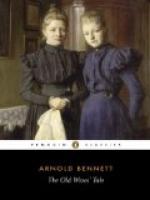Nothing but the servant had been changed in that house. The harmonium on which Mr. Povey used occasionally to play was still behind the door; and on the harmonium was the tea-caddy of which Mrs. Baines used to carry the key on her bunch. In the corner to the right of the fireplace still hung the cupboard where Mrs. Baines stored her pharmacopoeia. The rest of the furniture was arranged as it had been arranged when the death of Mrs. Baines endowed Mr. and Mrs. Povey with all the treasures of the house at Axe. And it was as good as ever; better than ever. Dr. Stirling often expressed the desire for a corner cupboard like Mrs. Baines’s corner cupboard. One item had been added: the ‘Peel’ compote which Matthew Peel-Swynnerton had noticed in the dining-room of the Pension Frensham. This majestic piece, which had been reserved by Sophia in the sale of the pension, stood alone on a canterbury in the drawingroom. She had stored it, with a few other trifles, in Paris, and when she sent for it and the packing-case arrived, both she and Constance became aware that they were united for the rest of their lives. Of worldly goods, except money, securities, and clothes, that compote was practically all that Sophia owned. Happily it was a first-class item, doing no shame to the antique magnificence of the drawing-room.
In yielding to Constance’s terrible inertia, Sophia had meant nevertheless to work her own will on the interior of the house. She had meant to bully Constance into modernizing the dwelling. She did bully Constance, but the house defied her. Nothing could be done to that house. If only it had had a hall or lobby a complete transformation would have been possible. But there was no access to the upper floor except through the parlour. The parlour could not therefore be turned into a kitchen and the basement suppressed, and the ladies of the house could not live entirely on the upper floor. The disposition of the rooms had to remain exactly as it had always been. There was the same draught under the door, the same darkness on the kitchen stairs, the same difficulties with tradesmen in the distant backyard, the same twist in the bedroom stairs, the same eternal ascending and descending of pails. An efficient cooking-stove, instead of the large and capacious range, alone represented the twentieth century in the fixtures of the house.
Buried at the root of the relations between the sisters was Sophia’s grudge against Constance for refusing to leave the Square. Sophia was loyal. She would not consciously give with one hand while taking away with the other, and in accepting Constance’s decision she honestly meant to close her eyes to its stupidity. But she could not entirely succeed. She could not avoid thinking that the angelic Constance had been strangely and monstrously selfish in refusing to quit the Square. She marvelled that a woman of Constance’s sweet and calm disposition should be capable of so vast and ruthless an egotism.




